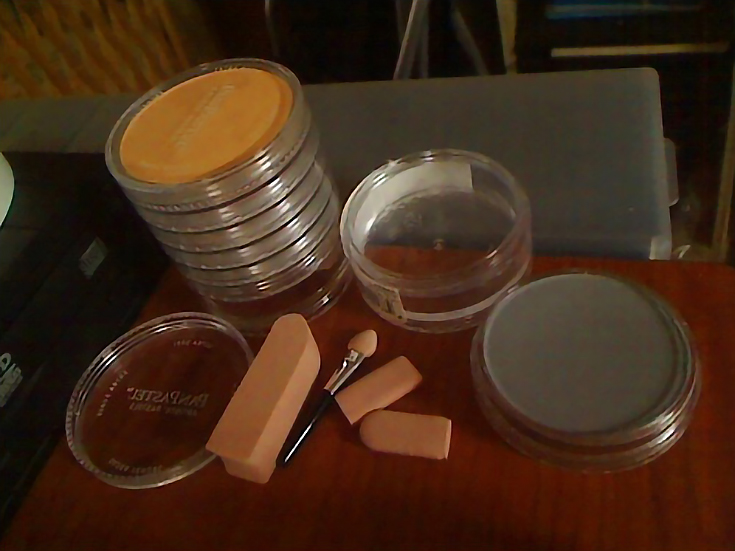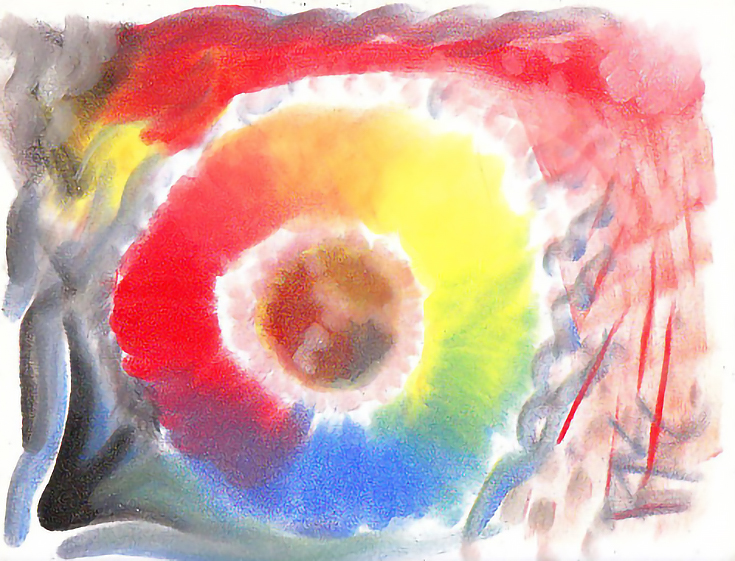PanPastel is a fairly new brand of artist pastels created by inventor and artist Ladd Forsline in 2007. Instead of a traditional pastel stick, PanPastels are simply pans of color meant to be scooped, spread, and smoothed using specially-made Sofft painting knives and sponges.
Years of research went into developing the PanPastel formula, culminating in a pastel medium that is softer than the super-soft Schminke or Sennelier sticks, velvety smooth, and so easily mixed that the range of 60 colors feels like more than enough colors for anyone.
Those colors includes 21 mass tones (pure colors plus white and black) and one tint and one shade for each mass tone. Colors come neatly stacked in clear little jars 2 3/8″ diameter with additional taller storage jars to hold various tools, including the Sofft painting knives, the short handle mini-applicators and the smaller sponges.
You can purchase PanPastels in sets of 5, 10, 20 and full range, as well as open stock. Each pan contains about a third more pigment than the average size pastel stick, so even if the open stock runs a little high (over $5 a pan) you’re definitely getting your money’s worth.
In addition, every speck of it can be scraped out onto a painting, and the amount of dust from the process is negligible—this makes PanPastels a good choice for both the frugal artist and anyone concerned about toxic pigments getting into the environment.
Here’s a photo showing an open pan of Paynes Gray on the right, an open storage jar with the tools that came with it, and a short stack of Tints with Orange Tint on top.
Since PanPastels come in stacks, they don’t include a separate lid per pan. Extra lids are available for $2.99 per eight-pack if you prefer to spread out your Pan Pastels to see all the colors at once and still keep your cat from treading in them.
I found it easier just to stack and unstack pans according to color groups, spreading out only while a painting’s in progress. Stacking pans leaves such a small footprint that I find them more convenient.
In the next photo you’ll see some of my tools. . . a few of them look like women’s makeup applicators, but artists who’ve tried cheaper makeup applicators found that they wear out faster. The micropore material has a dense, soft texture that picks up more color, too, and handling them is very different from other sponges I’ve used.
From left to right there’s my oval knife cover, then the bare oval knife, the flat knife with a used cover on it, a triangle knife with a fresh cover, a round-tip knife recently used. and the No. 2 Color Shaper. Lying across the knives is a used mini-applicator.
On the far right, back to front, there’s a stack of Tints with a round two inch sponge on it, the Paynes Gray pan with a pointed sponge, and a big oval sponge that I used to paint the sky in a recent painting.
The wedge shaped sponge and flat knife both create a mark similar to that of a flat brush in oil painting. Often I’ll use those without blending to achieve a painterly effect.
You can also use PanPastels for underpainting, especially on Colourfix, Wallis or other sanded pastel papers. That big oval lets me sweep broad strokes across the entire area of a big painting and spread them evenly. If I want to tone a page for using other pastels or before doing a negative painting, the big oval sponge is a tremendous convenience. It’s like having a three inch wash brush for watercolors or oils.
All Sofft tools clean up easily by swiping them on a paper towel. I normally use rags rather than paper towels (our household is keen on environmental issues) but when I tried using cloth rags, fuzz stuck to the tools, so real paper towels are a necessity.
When I started with PanPastels last year, I tested the primary colors to see if I could recommend this simplified palette to people who weren’t sure about investing a lot of money right away. The results were great—they mix as if they were paint and yet give a velvety surface texture that’s clearly pastel.
Here’s a look at these colors on a regular sketchbook page. (You’d get better results on a paper with more tooth.)
I used the round tip Sofft knife and created a color wheel in the center, then mixed all the primaries in the center to get some nice browns.
I also went in with white and lightened some of the side areas, tested different strokes with different mixes and added black to one corner before going over it with color.
I’d suggest testing your mixtures on a side sheet before using them in your painting. The darker colors are very strong—so, for example, it takes a lot of yellow and very little blue to get a mid-green hue.
You can also mix colors right in the pans, by the way. Load an applicator with one color, then swipe it over the next. If the top of the pan starts getting tainted with the other colors, just wipe across it with a clean sponge or paper towel—that restores the original color fast.
Based on all my experiments, I think PanPastels are a great invention. They offer many new techniques for mixing and applying pastel medium to any pastelist’s arsenal, and as a bonus, their compactness, cleanliness and speed lends itself to plein air painting, too.
If you do take them out in the field, it may help to build foam board trays with lids so that you don’t have to keep unscrewing your stacks. Donna Aldridge has built one like that, and many others have followed her example.
Naturally, since PanPastels are still new, we are only beginning to understand all the things you can accomplish with them. However, if you’re looking for a soft, very mixable pastel, I don’t think you need to look much farther.
For more information about PanPastels, visit www.PanPastel.com.
This post may contain affiliate links.




